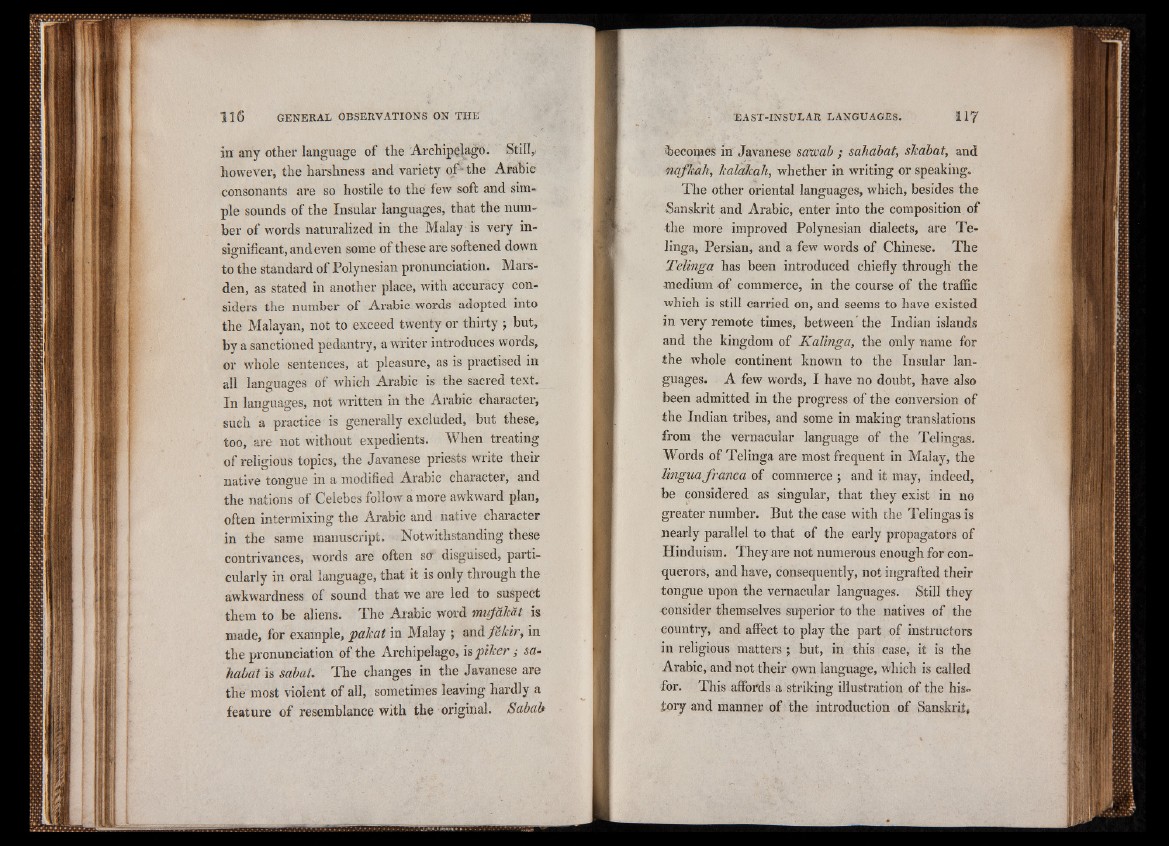
in any other language of the Archipelago. Still,,
however, the harshness and variety of* the Arabie
consonants are so hostile to the few soft and simple
sounds of the Insular languages, that the number
of words naturalized in the Malay is very insignificant,
and even some of 25 ' these are softened down to the standard of Polynesian pronunciation. Mars-
den, as stated in another place, with accuracy considers
the number of Arabic words adopted into
the Malayan, not to exceed twenty or thirty ; but,
by a sanctioned pedantry, a writer introduces words,
or whole sentences, at pleasure, as is practised in
all languages of which Arabic is the sacred text.
In languages, not written in the Arabic character,
such a practice is generally excluded, but these,
too, are not without expedients. When treating
of religious topics, the Javanese priests write their
native tongue in a modified Arabic character, and
the nations of Celebes follow a more awkward plan,
often intermixing the Arabic and native character
in the same manuscript. Notwithstanding these
contrivances, words are often so disguised, particularly
in oral language, that it is only through the
awkwardness of sound that we are led to suspect
them to be aliens. The Arabic >vord mufâMt is
made, for example, pakat in Malay ; and fekir, in
the pronunciation of the Archipelago, is piker ,• sa-
habat is sabat. The changes in the Javanese are
the most violent of all, sometimes leaving hardly a
feature of resemblance with the original. Sabab
becomes in Javanese sawab ; sahabat, slcabat, and
naf/cáh, kalakah, whether in writing or speaking.
The other oriental languages, which, besides the
Sanskrit and Arabic, enter into the composition of
the more improved Polynesian dialects, are Te-
linga, Persian, and a few words of Chinese. The
Telinga has been introduced chiefly through the
medium of commerce, in the course of the traffic
which is still carried on, and seems to have existed
in very remote times, between the Indian islands
and the kingdom of Kalinga, the only name for
the whole continent known to the Insular languages.
A few words, I have no doubt, have also
been admitted in the progress of the conversion of
the Indian tribes, and some in making translations
from the vernacular language of the Telingas.
Words of Telinga are most frequent in Malay, the
lingua franca of commerce ; and it may, indeed,
be considered as singular, that they exist in no
greater number. But the case with the Telingas is
nearly parallel to that of the early propagators of
Hinduism. They are not numerous enough for conquerors,
and have, consequently, not ingrafted their
tongue upon the vernacular languages. Still they
consider themselves superior to the natives of the
country, and affect to play the part of instructors
in religious matters ; but, in this case, it is the
Arabic, and not their own language, which is called
for. This affords a striking illustration of the history
and manner of the introduction of Sanskrit,